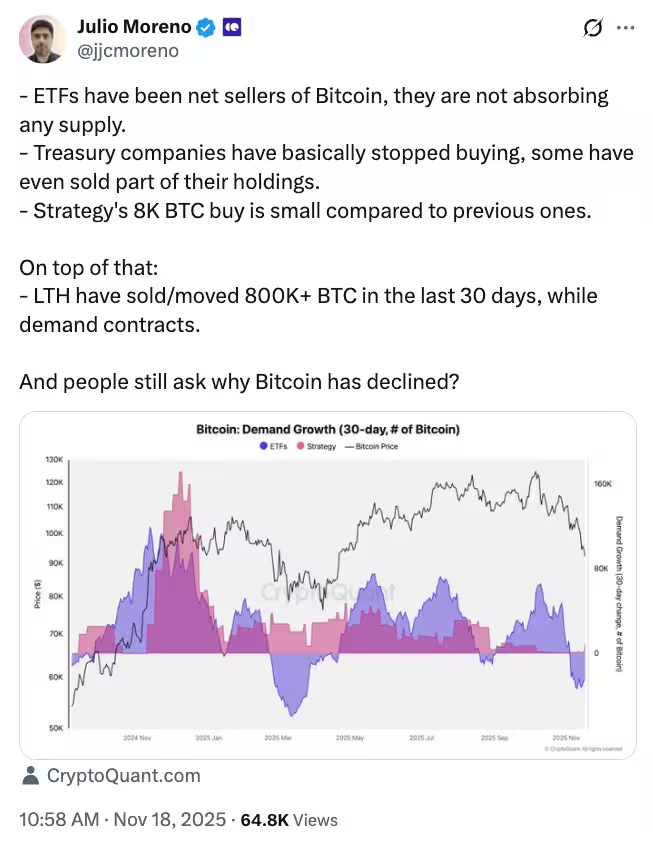4 Minutes
Bitcoin slips into 'most bearish' territory as institutional demand fades
Bitcoin has moved into what analytics firm CryptoQuant calls the "most bearish" phase of the current cycle, driven by weakening institutional demand and negative market indicators. BTC's price dropped well below the 365-day moving average — a widely watched technical threshold — and CryptoQuant's Bull Score Index has plunged to a deep 20/100, signaling elevated downside risk for traders and investors.
Technical triggers: 365-day moving average and Bull Score
CryptoQuant highlights the 365-day moving average, currently around $102,000, as a critical demarcation. When Bitcoin trades beneath that level, it historically aligns with the start of extended bearish periods. The firm's Bull Score Index, which aggregates on-chain and market signals, has declined to extreme bearish territory, reflecting dwindling momentum and reduced conviction among major market participants.
Institutional purchases cool off
The pullback coincides with a marked slowdown in corporate and treasury buying. Even high-profile acquisitions, such as Michael Saylor’s Strategy’s most recent purchase of 8,178 BTC (roughly $835 million), were smaller than earlier accumulations by the same firm. CryptoQuant’s head of research Julio Moreno noted on X that treasury companies have mostly stopped increasing their BTC holdings — and some firms, like Metaplanet, haven’t bought since September.

Source: Julio Moreno
Corporate demand was a powerful driver of price appreciation in 2024–2025, but those flows appear to be tapering. This reduction in direct corporate buying removes a key source of buy-side pressure that had previously helped sustain the rally.
ETF inflows slow, catalysts fade
Institutional exposure through ETFs has also decelerated. Year-to-date inflows into Bitcoin ETFs stand at about $27.4 billion — roughly 30% below the $41.7 billion recorded last year, per CoinShares data. The lower ETF inflows are compounding the effect of reduced treasury purchases, leaving fewer buyers to absorb selling pressure.
CryptoQuant points out that some of the decisive catalysts that lifted BTC in recent years are now absent or priced in. Events such as the political developments in 2024 and the wave of new Bitcoin Treasury Companies in 2025 helped push prices above six figures and then beyond $120,000. With those tailwinds gone, the market is searching for new, credible catalysts to reignite sustained demand.
Where does the market go from here?
The report suggests the current decline aligns with Bitcoin’s historical four-year cycle pattern (previous cycles: 2014–2017, 2018–2021). By that metric, the 2022–2025 cycle may be concluding. That said, CryptoQuant cautions this doesn’t imply an instantaneous collapse. The platform notes Bitcoin has experienced approximately a 28% drawdown and is gravitating toward important support in the $90,000–$92,000 range.
Even during bear phases, Bitcoin has produced sharp rebounds — 40%–50% rallies over a few months are possible, the report adds. However, until BTC reclaims the 365-day moving average, that level (near $102.6K) is likely to act as a substantial resistance for any move higher.
Near-term price action and investor takeaway
Hours after CryptoQuant’s weekly bulletin, Bitcoin briefly dipped below $90,000, reaching as low as $88,400 — the weakest point since April 2025 — before staging a modest recovery to around $91,650 at the time of publication. For investors and traders, the immediate focus will be on whether support around $90K–$92K holds, whether ETF inflows stabilize, and if any fresh institutional catalysts emerge to revive demand.
In summary, BTC's technical and on-chain signals point to a bearish phase, but historical precedent shows volatility and swift recoveries remain possible. Market participants should weigh risk management and monitor institutional flows, ETF activity, and macro developments for signs of a trend reversal.
Source: cointelegraph


Leave a Comment